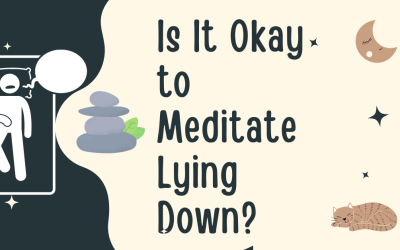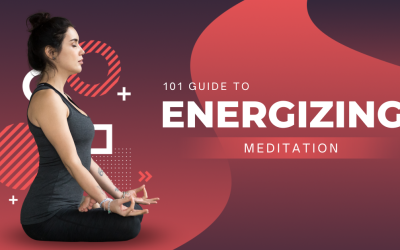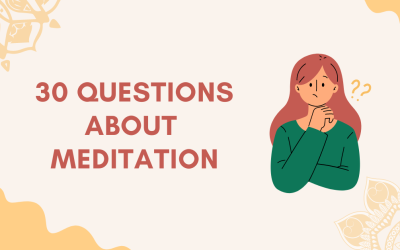Do you want to learn how to meditate longer? You’re not alone. Life gets busy. When you have so many things vying for your attention (work, family, social media – the list goes on), finding the time and the mental energy to meditate longer can be a serious challenge.
Fear not! We’re here to help. Our guide provides helpful tips on how to extend your meditation session and maximize the benefits of this ancient practice.
Try Different Types of Meditation
If you want to learn how to meditate longer, one of the first things you need to consider is the type of meditation you’re doing. While mindfulness meditation works for many people, others find that sound or candle meditation works better for them.
Many people don’t realize that there are so many different types of meditation. The great news is that you can experiment with all of them until you find one – or a few – that works well for you.
Let’s explore some of these meditation types:
Mantra Meditation
If you’re having trouble staying in the moment and quieting your mind, mantra meditation may be a great option for you. With this type of meditation, you repeat a mantra – either out loud or to yourself – and focus all of your attention on it.
Repeating that mantra makes it easier to keep those intrusive thoughts at bay and you in the present moment. You can recite any mantra you want. Some popular and traditional mantras are:
- Om
- Aham Prema
- Ham-Sah
- Namo Amitabha
- Om Shanti, Shanti, Shanti
- I want nothing. I am nothing. I do nothing
- I am enough
- I can and I will
You can change your mantra with every practice to match what you’re feeling in the moment. For example, if you’re feeling low, reciting the mantra “I am enough” may help you stay in the present and even start to heal from your trauma.
There are many benefits of mantra meditation that go beyond helping you meditate for longer.
Candle Meditation
Some meditators, especially beginners, struggle to stay in the moment when they close their eyes and try to empty their minds. If this sounds like you, then candle meditation may be a better alternative for you.
Also known as candle gazing, candle meditation is all about staring at or fixating on the flame of a candle while you meditate. Some people find it easier to get into a trance-like or meditative state when staring at an object like a candle flame.
If you’re struggling to meditate for more than just a few minutes at a time, give candle meditation a try. Just make sure that you’re following safe practices when using your candles.
Chakra Meditation
Sometimes, when we struggle to meditate for longer, the problem is much deeper than having short attention spans. For some, having an imbalance or blockage in one of the seven chakras prevents them from experiencing a full, deep meditation.
Chakra imbalances can manifest as anxiety, depression, anger, sadness, feeling unworthy, mental confusion, headaches and more.
If you’re struggling to extend your sessions and you’ve tried other types of meditation, you may be one of the many people who have a chakra imbalance. The great news is that chakra meditation can help remove these blockages, allowing you to heal and progress in your practice.
Group Meditation
When you’re meditating at home or outdoors, it’s easy to get distracted by your to-do list, noises and thoughts. Some people find that it’s much easier to meditate and extend their practice sessions when they’re in a group setting.
When you attend a group meditation, you’re joining other people who have the same goals, and you’re in a dedicated space for meditation. The practice becomes more intentional, and it’s much easier to shut the door to distractions.
If you’re a beginner, you may also benefit from receiving proper guidance or pointers that the instructor or group leader may give.
Many cities have group meditation classes. Check social media groups or ask friends for recommendations if you’re struggling to find classes near you.
Sound Meditation
Sound meditation is a unique type of meditation where sounds become the focus of your attention and awareness. Many people find that focusing on sounds is much easier than emptying their minds and allows them to truly be in the moment.
Singing bowls are often used in this type of meditation to help improve focus and promote relaxation. Other tools used in sound meditation include:
- Chanting
- Rattlers
- Tuning forks
Research has found that sound meditation may be an effective way to reduce anxiety, depression and mental health. If you’re struggling with mindfulness meditation, give this one a try.
Cord Cutting Meditation
Cord cutting meditation is a very special type of practice that focuses on cutting ties with someone who may be robbing you of your energy and peace.
These are people you once had a deep connection with. They’re no longer in your life, but they still have a hold on you (think exes, old friends, etc.). Just thinking about them causes you stress and anxiety.
Cord cutting meditation helps you let go of this connection so that you can start living life on your own terms.
If you have someone or multiple people in your life that are still draining your energy even though they’re gone, cord cutting meditation may work well for you. Severing these connections may also free up mental energy so that you can meditate for longer.
Kundalini Meditation
Kundalini meditation is an ancient practice that dates back to at least 500-1,000 BC, although it’s only been recently introduced to the Western world.
The goal of Kundalini meditation is to move energy through the body. The belief is that everyone has coiled energy that sits at the base of their spines. But with the right breathwork and meditation, you can awaken and unravel this energy.
This type of meditation is more active than others, and there’s a great focus on breath and alignment. Because the practice involves different movements and breathing exercises, some people experience emotional discomfort at first. However, with practice and time, this form of meditation can become a powerful tool for managing your emotions and healing past trauma.
Energizing Meditations
If you’re having trouble meditating for longer because you just don’t have any energy, why not try an energizing meditation?
Initially, you may still struggle to meditate for longer than usual, but over time, those quick, energizing sessions may help you stay in a meditative state for longer.

Improve Your Meditation Technique
Learning how to meditate longer takes time, practice and patience. But it also requires the right technique.
Posture is a common culprit because pain or discomfort can stop you from being able to sit quietly for long periods of time. Experimenting with different hand and meditation positions can also help.
Let’s look at some ways you can improve your meditation technique and, hopefully, start meditating for longer.
Work on Your Seated Meditation Posture
Traditionally, meditation is performed in a seated position. You don’t have to be seated while you meditate, but many people find that they’re most comfortable and alert in this position.
The problem is that sitting cross-legged or in lotus position can sometimes put extra stress on the knees and or cause discomfort. If you’re feeling uncomfortable in this position or you’re fidgeting a lot, it may be time to change your position and posture.
Rather than sitting cross-legged on the floor, try sitting upright in a chair with your feet flat on the floor and your hands resting in your lap. To maintain good posture, try sitting at the center of the seat and keeping your back away from the back of the chair.
If you prefer to sit cross-legged but want to avoid discomfort, try using a meditation cushion or blanket. Sitting on a cushion or rolled-up blanket will keep your knees lower than your hips, which will alleviate pressure on your knees. If you’re sitting on a hard floor, try putting another blanket down to cushion your ankles.
Regardless of whether you meditate in a chair or seated on the floor, it’s important to make sure that your:
- Back is straight but relaxed
- Neck and head are aligned over your spine
- Arms are resting in your lap
Follow these pointers and you may find it’s much easier to stay comfortable and in your meditative state for longer.
Know Where to Put Your Hands
Your posture and position are important when meditating because it helps you get into a deeper meditative state and stay there for longer. But many beginners and even more experienced meditators forget that your hand position is also a part of your posture.
Knowing where to put your hands is important, and the right position can help improve your practice. Some hand positions are more comfortable than others.
But it’s also important to remember that it’s perfectly okay to simply rest your hands on your knees. Complicated hand positions may take your attention away from your practice, so start with a position you feel comfortable in.
Over time and once you’ve successfully extended your meditation sessions, you can start experimenting with different hand positions.
Remember that hand positions can also reflect your practice’s intentions, so it’s important to choose the right one.
Try Laying Down
If you’ve tried different seated positions and found that they just aren’t working for you, you may be wondering whether it’s okay to lie down while meditating.
If you want to extend your practice but just can’t stay seated for long periods of time, it’s perfectly acceptable to lie down. People with back and knee pain often find that lying down is the best way to meditate for longer.
Choose the Right Time of Day
If you’re really struggling to extend your meditation time and you’ve tried everything else on this list, it may be time to sit down and look at when you’re practicing. Are you practicing early in the morning, just before bed, or in between meetings?
Sometimes, the most convenient time isn’t always the best time.
- If you’re meditating just before bed, you may be too tired to stay alert during your practice.
- If you’re practicing first thing in the morning, you may be too distracted by thoughts of having to leave for work or other obligations.
- If you’re practicing during your lunch break, you may not have enough time to truly get into a meditative state.
Experiment with different times of the day. Make your practice intentional and choose a time when you can really dedicate your energy to your meditation session.

Create a Dedicated Space for Regular Practice
We’ve talked a lot about being intentional with your meditation practice and for a good reason. The more intentional you are about meditation, the easier it will be to extend your sessions.
Creating a dedicated space for your practice is a great place to start. When you enter this space, your brain will automatically start getting into the right mindset. It’s easier to shut out distractions because you’re in this special place where your only purpose is to sit quietly with yourself.
Let’s look at how to create a dedicated meditation space in your home.
Choose a Quiet, Distraction-Free Place
The best meditation space is one that is quiet and free of distractions. Choose a peaceful corner of your bedroom or even your home office. If you have the space, you may consider creating your own meditation room.
The size of the space doesn’t matter. It can be as small or large as you want – as long as you dedicate that space to meditation only.
Create an Altar
Once you have a designated space in your home for meditation, you can set yourself up for success by adding things that will enhance your practice or help you stay in the right mindset.
Many people find that creating an altar is a great way to initiate their practice, practice gratitude and help them stay on track.
Altars don’t have to be religious in nature. They can simply serve as the place you sit in front of while meditating. Some people add statues of The Buddha and mala beads to use during their practice. Others have a singing bowl, incense or a combination of all of these things.
The goal is to create a little space where you have everything you need for your practice. Your mind will begin to associate your altar with meditation, which will help you get into a meditative state more quickly.
Use Meditation Balls
Baoding balls, or meditation balls, help many people improve and extend their meditation time. They can be used for enhanced attention, to reduce anxiety and even help with hand dexterity.
While they may not be an accessory or tool for everyone, meditation balls are something to consider if you’re struggling to stay focused during your practice.
Add a Bench or Cushion
When creating your meditation space, you may want to consider ways to support your body while sitting cross-legged. One great way to do that is to add a meditation bench or cushion.
These benches and cushions are specially designed to support your knees and make it more comfortable to sit upright while meditating.
Many people also find that it’s much easier to engage in deep breathing when they’re sitting on a meditation cushion or folded blanket.

Understand the Benefits of Meditation
If you’re having a hard time extending your meditation practice sessions, it may not be your technique, your space or even the type of meditation you’re performing. The problem may be that you’re not seeing the true value of the practice and how it can improve your life.
Understanding the benefits of meditation may help. Science is now taking a more serious look at how meditation can enhance your life. Some of the many benefits of this ancient practice include:
- Improved mental health
- Less stress and anxiety
- Better ability to handle stress
- More positive outlook on life
More research continues to be published on the benefits of meditation for mental and physical health. Taking the time to look at the science behind this practice and its effects may help you find a greater purpose in meditating. Purpose may make it easier to meditate for longer periods of time.
Understand the Jargon
When you first dive into meditation and learn about the practice, you may come across words and phrases that are new to you.
Understanding the jargon may help you meditate for longer for a number of reasons.
- These terms may refer to different techniques used in meditation, which may help you improve the way you meditate.
- Many of these terms are mantras that you can use to get into a deeper meditative state.
It’s worth exploring some of the most common meditation words and mantras to deepen your knowledge of the practice.
Explore Questions About Your Meditation Practice
Whether you’re a beginner or a more experienced meditator, you may have unanswered questions that are getting in the way of your practice. For example, you may be wondering whether you’re trying to meditate for too long or whether you should close your eyes.
When we feel unsure about something, we often struggle to move forward with confidence.
A little research can go a long way in giving you the answers you need to meditate for longer because you’re not fixated on whether you’re doing something wrong.
Take the time to write down questions you have about meditation, and start doing some research. You may find that you’re spending too much time worrying about the length of your sessions or your position rather than allowing yourself to be in the moment.

Know What to Do After Meditating to Improve Future Sessions
Sometimes, it’s not the meditation session itself but what you do afterward that makes it difficult to enjoy a prolonged meditation.
For example, let’s say that you typically meditate right after work. You may struggle to extend your sessions because you’re always preoccupied with having to make dinner or getting the kids ready for bed afterward. You’re jumping from a relaxed state straight to a chaotic one. Your body may anticipate this transition, making it harder to stay in that relaxed state.
But what if you changed the things you do after meditation? What if learning how to meditate longer was as simple as changing your after-practice routine?
Taking some time to consolidate the experience and journal can help you slowly transition back to your normal routine, giving your mind and body time to adjust. Over time, you may find it much easier to meditate for longer because your mind isn’t ready to race to the next thing after 15-20 minutes.
Try changing your after-meditation routine to see if it impacts your practice and how long you can stay in a meditative state.
I Still Can’t Meditate Longer – What Now?
Learning how to meditate longer takes time and patience. But what if you’ve been experimenting with different techniques and still haven’t been able to extend your meditation time?
There are many reasons why you may still be struggling to meditate for longer.
- You may have some trauma that needs healing so that you can move past it and continue with your practice.
- Practice makes perfect, and time may be what’s needed to extend your meditation sessions.
- Your expectations may be too high (expectations themselves are an issue that may be hindering your meditation). Start by trying to extend your meditation by just a few minutes per day rather than 20-30 minutes or more.
Remember to be kind to yourself. You are only human, and it takes years to master meditation. With patience, practice and self-love, you will find yourself slowly able to extend your meditation sessions.
The Bottom Line
Many people struggle with learning how to meditate for longer, especially beginners who are still new to the practice. Following the tips above can help you learn how to slowly extend your sessions and get deeper into meditation.






